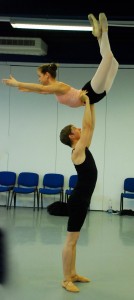 My name is Henrik Lamark, I’m a 23 year old professional ballet dancer born in Norway, but currently situated in Czech Republic.
My name is Henrik Lamark, I’m a 23 year old professional ballet dancer born in Norway, but currently situated in Czech Republic.
1. How did you get involved in dance?
I started dancing at age 4. My mother told me I used to sneak out of the house and down to a football field just next door. My parents were sure I was interested in the kids playing there, until they one day found me in the window of the club-house, watching a ballet class inside. I told my mother I wanted to do that, and so they signed me up for ballet classes. Although starting early, my training didn’t get really serious until high school because of the lack of a proper school in my area, but I learned the most important thing in the first years of my life; the love of dance!
2. What are you currently doing in dance?
I’m currently working for a smaller company in Czech Republic. We dance most of the classcal ballets (just presenting a new production of Giselle this month), plus various modern and neoclassical works. In March we have this seasons second premiere; a rock-ballet tributing U2, choreographed by canadian-born Eric Trottier. The show fits me like a glove, it’s rock, it’s ballet, it’s contemporary and it’s filled with testosterone!
3. What is it like to dance in the Czech Republic?
I found that as a dancer, the place you are situated doesn’t matter as much as in other professions. For me, choosing Czech Republic was an accident more than something I thought about a lot – I got the opportunity to work in the same place as my girlfriend – who is also a dancer. That doesn’t happen every day, so it was really not so hard of a decision. I have to say, although the Czech are great people (and their beer is terrific), it’s probably not the place I will “settle for good”. But as a young dancer, you have to take what you can, so it’s probably a “gypsy-life” waiting for me still some years. But it’s an interesting life, full of new experiences.
4. Can you share anything about the perspective on dance in Norway?
Dance is getting more and more popular in Norway, leading to an increasing amount of both dancers, and audience. We have some world leading choreographers on the contemporary stage, and the National Ballet is strengthening their position amongst the European countries when it comes to neo-classical and modern works. But we are missing the cultural history on dance you find for example at our neighbors in east, Sweden and Russia, and so we don’t have the same audience and interest when it comes to classical ballet. The dance audience in Norway is young, it’s a new generation that prefers a more modern take on things than the old ballet can offer.
5. What is your greatest challenge as a dancer?
As a male dancer, I am interested in showing the world a broader perspective on us than what the usual stereotypes provide. Men, as women, can communicate so much with dance, but are often written off before they get the chance to because of stereotypes and just plain lack of knowledge amongst the “people in the street”. I wish to do something about it, but I am not able to do it alone. This is in my opinion the greatest challenge for any male dancer; to change what people think of us. Male dancers differs as much from each other as any other group of people! In my blog, Tights and Tiaras I introduce people to ballet as I see it, kind of like “ballet for dummies” if you want, hoping to improve knowledge about ballet in general, and by doing so, also change the stereotypes regarding male dancers.
Plain dancewise, any dancer in the world has something he or she can improve, dance is never perfect. That’s the perfection of it!
6. What is your strongest quality as a dancer?
I think my strongest asset as a dancer is that I am a good partner. My upper body strength of course helps, but I tend to understand the girls movements, which makes it easier to support her. I also had excellent teachers in pas de deux at the Hungarian Dance Academy that gave me a good base for partnering.
I am told I am a good actor. It’s hard to judge oneself, but I know I enjoy shaping a character, that be a peasant in the corps de ballet, or some bigger solo role – I always try to make myself become the person I am on stage. With my 190 centimeters and wide shoulders, I appear big and strong, and tend to get “alpha-male” roles. Not that it bothers me. I am, after all, a Norwegian viking.
7. Can you share a personal best—a highlight from some point in your dance career?
It’s hard to chose one moment. My graduation concert comes to mind, dancing solo for a full Budapest operahouse was an extreme experience! The first time I got a job as a dancer was also a absolute high in my career, the feeling of finally achieving what I wanted for so long. But what really stands out, is something I didn’t realize was a great point in my career until much later. When I was a kid, I had a hard time at school. I was the only boy dancing ballet in my whole city. For more than 10 years, everywhere I went, “everyone” knew who I was, and most of them had some comments on what I do. There was more than one time I wanted to quit, but I didn’t. Sticking that out is what I am most proud of today as a dancer, and person.
8. What advice can you give to other men who want to dance?
I’ll quote the nike-commercials: Just DO it! Never give up! It’s really a great saying. If it’s about getting a hard time for dancing, or getting that role, or managing those pirouettes – just DO it! The most important person in your life is yourself. So be that person. Nothing makes it perfect, but practice makes it better!
When it comes to more technical stuff, I love to see male dancers being real men. Both in the sense of showing some testosterone, but more importantly, to show who they are! I see many dancers with great technique, but lacking that spark that makes it interesting – the look in the eyes, the posture of the upper body – it’s a very important part of dancing, that we might not practice as much as the ballet class itself. As an audience, I want to see the dancer first, and then what he can do.
9. Can you share any tips for partnering?
 I think the most important thing a partner can do – that goes for both genders – is to communicate. The guy has to pay attention to the language of the girls body. Once you understand what she needs to be positioned and on balance, everything is much easier. The girls have to make sure they show us guys just what they need, or we’ll get confused – kind of like in any relationship, really. 🙂 Of course it helps if the boy is strong as Goliath, but let’s not forget that David won the fight. There’s a whole technique to partnering, and by learning it, I was able to do lifts and tricks my partner, or I, never thought we could. In the end, there’s a lot of logic to it. Girl falling forward? Weight back! As to what muscles are concerned, strong abdominals help more than big biceps. And guys: don’t forget your legs! Using the thighs right is the difference between first arabesque and “let’s try again”. Straight back, good plié, communicate with your partner, and you can lift anyone!
I think the most important thing a partner can do – that goes for both genders – is to communicate. The guy has to pay attention to the language of the girls body. Once you understand what she needs to be positioned and on balance, everything is much easier. The girls have to make sure they show us guys just what they need, or we’ll get confused – kind of like in any relationship, really. 🙂 Of course it helps if the boy is strong as Goliath, but let’s not forget that David won the fight. There’s a whole technique to partnering, and by learning it, I was able to do lifts and tricks my partner, or I, never thought we could. In the end, there’s a lot of logic to it. Girl falling forward? Weight back! As to what muscles are concerned, strong abdominals help more than big biceps. And guys: don’t forget your legs! Using the thighs right is the difference between first arabesque and “let’s try again”. Straight back, good plié, communicate with your partner, and you can lift anyone!
10. What is next for you on the horizon in terms of dance?
Well, first off is the U2-ballet I mentioned earlier. I’m also looking for a new job, so I guess I will go for some auditions. Man, I hate auditions. I’ll take the stage and an audience any day over a studio with some strict faces. But sometimes, you just “gotta do what you gotta do”, right?! I want to continue to improve my technique, and I wish to get stronger, especially in my legs, so I guess I’m looking at some gym time. I’d also love to perform a new pas de deux from one of my favorite choreographers, Levente Bajári from Hungary. He made a duet on my girlfriend and me a year ago, and I just want more! I tend to make my road as I walk it, so what’s just a wish today can be reality tomorrow. The best thing you can do is to just follow my blog, and I’ll be sure to keep you posted!





